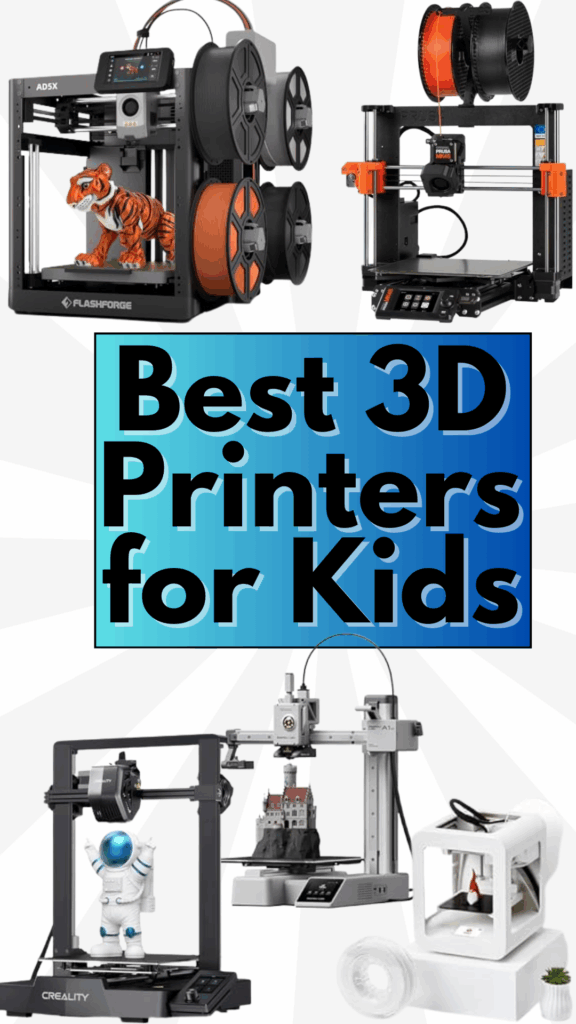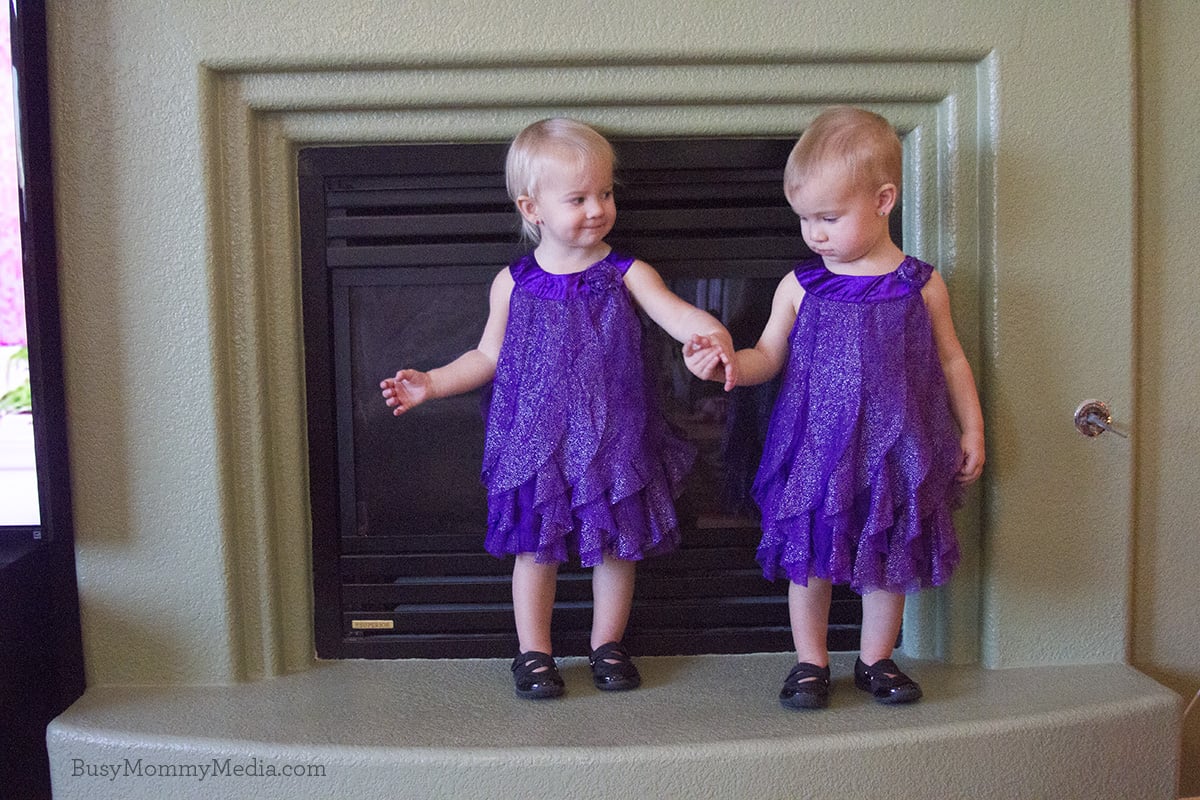Best 3D Printers for Kids (2025): Safe, Easy Models for Beginners
This post contains affiliate links. All opinions are our own.
Finding the best 3D printers for kids can feel overwhelming, especially when you want something safe, reliable, and easy for beginners to use. This guide breaks down the top kid-friendly 3D printers for 2025 so you can pick the right one for learning, creativity, and hands-on STEM projects at home.

3D printing has become one of those things my kids never get tired of. They’ve printed everything from customized fidget toys to school project pieces to little trinkets they trade with friends, and it’s honestly been a really fun hobby we’ve picked up as a family.
There’s something magical about watching a design slowly take shape layer by layer, and it still surprises me how quickly kids pick up the process.
What started as a curiosity in our house has turned into years of experimenting with different printers, settings, and materials. Some models were amazing right out of the box, and others… not so much. But all that trial and error has made it easy to see which 3D printers are actually kid-friendly and which ones are better left to serious hobbyists.
Why 3D Printing Is Perfect for Kids
We’ve experimented with 3D printers for years, and it’s become one of those hobbies that keeps our kids creating, problem-solving, and learning without feeling like schoolwork. There’s something incredibly satisfying about watching a design go from an idea to a real, tangible object—especially when kids can do most of it on their own. Over time, we’ve tested different printers, figured out what actually works for beginners, and learned which features matter the most for kids.
3D printing isn’t just a fun hobby. It can be a meaningful way for kids to use their creativity. They can design gifts for friends, make replacement parts for broken toys, or print small trinkets that brighten someone’s day. One of my favorite examples is a pediatric nurse who uses a 3D printer to make little toys for young patients during tough hospital stays. Stories like that show how uplifting and positive 3D printing can be, and kids love feeling like they are creating something that matters.
You may also like: Best Drones for Kids
What Parents Should Look for in a Kids’ 3D Printer
If you’re new to 3D printing, it can feel a little overwhelming. Safety, reliability, and ease of use all matter, but so does choosing a printer that won’t require constant troubleshooting or technical knowledge. Kid-friendly 3D printers should be simple to set up, quick to maintain, and designed with safeguards that give parents peace of mind. After years of using them in our home, we’ve found that the best models strike the right balance between creativity and practicality.
The Best 3D Printers for Kids in 2025
The good news is that there are more kid-friendly 3D printers available than ever before, and many of them are surprisingly affordable. Whether your child wants to create toys, tools, miniatures, art projects, or school assignments, these printers make it easy to get started. Below, we’re sharing our top picks for the best 3D printers for kids in 2025—chosen for ease of use, safety features, print quality, and long-term durability.
What Kids Can Learn from 3D Printing
One of the best things about 3D printing is how much kids learn without even realizing it. They think they are just making another fidget or printing something “essential” for their room, but behind the scenes they are building real skills that quietly make you feel like you’re winning at this parenting thing. It is hands-on learning that keeps them interested far longer than most educational activities ever do.
1. Creative Problem-Solving
Not every print turns out perfectly, and that is actually the good part. Kids figure out how to fix things, tweak designs, and try again without melting into a puddle on the floor. Watching them troubleshoot a failed print is one of those rare moments where you can practically see their brains working.
2. Spatial Awareness and Design Thinking
3D printing teaches kids how shapes fit together and why some designs just do not survive contact with the real world. They start planning ahead, thinking things through, and noticing details. It is like sneaking critical thinking into their day without them catching on.
3. Hands-On STEM Learning
Kids absorb STEM concepts fast when they are having fun. They learn about temperatures, materials, supports, and how tiny changes affect the final outcome. It is real engineering in kid-friendly form, and you do not have to bribe them to participate.
4. Patience and Precision
3D printing takes time, which means kids learn patience whether they planned on it or not. They check the file, get the first layer going, and then let the printer work. It is surprisingly calming, especially compared to hobbies that end with glitter stuck to your floors for a month.
5. Confidence and Independence
There is nothing quite like watching your kid hold something they created completely on their own. Every successful print gives them this little boost of confidence that makes them want to take on bigger projects. It is a nice change from the “Mom, can you do this for me?” phase.
3D printing gives kids a chance to create, experiment, and learn in a way that feels exciting and empowering. They think they are playing. You know they are learning. Everyone wins.
Safety Tips for Kids Using 3D Printers
3D printing is very safe for kids when they understand a few simple guidelines. These tips help keep the process fun, supervised, and stress-free for everyone.
1. Choose a good location
Keep the printer in a spot where you can easily see and hear it. Kids can manage most steps on their own, but it helps to check in on prints occasionally.
2. Teach kids about hot surfaces
The nozzle and heated bed get extremely hot during printing. Kids should not touch the printer while it is running and should wait until everything cools before removing a print.
3. Start with kid-safe filament
PLA is the best beginner option because it is low-odor, easy to work with, and one of the safest materials for indoor printing.
4. Remind kids not to move the printer mid-print
Bumping or adjusting the printer while it is printing can cause failed prints or damage parts.
5. Review slicing settings together
Beginner printers usually handle temperatures automatically, but it is helpful for kids to double-check settings until they learn how everything works.
6. Encourage slow, supervised learning at first
A little guidance goes a long way. Most kids pick up the process quickly and become very independent after a few successful prints.
7. Keep tools and small parts organized
Scrapers, extra nozzles, and filament cutters should be kept in a safe, easy-to-reach container so kids do not misplace or misuse them.
What to Look For in a Kids’ 3D Printer
Choosing the right 3D printer for kids can feel overwhelming, especially if you are new to 3D printing. These key features make the learning process easier and help ensure your child has a positive first experience.
1. Easy setup and auto leveling
Printers with auto leveling and simple calibration are much easier for beginners. This cuts down on frustration and lets kids focus on making things instead of troubleshooting.
2. A simple, beginner-friendly interface
Touchscreens, clear menus, and easy load/unload buttons make a big difference for kids who are just getting started.
3. Fast but stable printing
Kids love fast results, but speed needs to be paired with good stability. Look for printers that maintain accuracy even at higher speeds.
4. A safe, reliable extruder
Direct drive extruders handle filament more smoothly and clog less often, which is ideal for kids learning how to load and change materials.
5. Compatibility with PLA filament
PLA is the safest and easiest filament for kids. Make sure the printer works well with PLA without requiring advanced settings.
6. A decent build volume
Kids often start with small toys but quickly want to print bigger things. A moderate build plate gives them more flexibility without making the printer overwhelming.
7. Good community support and resources
Beginner printers with strong user groups, helpful tutorials, and active support teams make learning much smoother for kids and parents.
8. Upgrade potential
Some kids grow fast in this hobby. Printers that support future upgrades like multi-color attachments or larger nozzles can grow with their skills.
Best 3D Printers for Kids
If you’re looking for a 3D printer that kids can actually use without constant help, this one is such a great pick. The Bambu Lab A1 Mini has pretty much taken over the beginner 3D printing market because it’s fast, quiet, and unbelievably easy to use. Ours was ready to go in about 20 minutes, and from there it handled all the calibration on its own.
Kids love how quickly it prints (it’s seriously fast), and you can upgrade to multi-color printing later with the AMS Lite attachment. The touchscreen is simple, the maintenance is minimal, and the automatic leveling + active flow rate compensation means smooth, clean prints without the frustration that comes with most starter printers.
If you want a beginner-friendly 3D printer that feels high-end but is easy enough for kids to learn on, this is one of the best options out there.
If you want a beginner-friendly 3D printer that prints fast and consistently, the Creality Ender 3 V3 SE is a great choice. This was the printer my kids started out with and it worked really well as their first printer. It is quick to set up, the auto leveling takes the stress out of calibration, and the upgraded Sprite extruder feeds filament smoothly without constant tinkering.
The dual Z-axis screws and reinforced guide rods keep prints stable and accurate, which makes a big difference when kids are printing toys or school project pieces. It handles PLA, TPU, and PETG easily, and the print speed is impressive for the price. If you want something that is easy to learn on yet capable enough to grow with your kids as they experiment, this is a solid pick.
A powerful, multi-color printer that is great for kids who want speed, creativity, and room to grow
If your kids are ready for a more advanced 3D printer, the FlashForge AD5X is an impressive upgrade. It supports multi-color printing with up to four colors at once, which opens up a lot of creative possibilities for kids who want their designs to look more polished and detailed. The 1-click auto leveling keeps things simple, and the CoreXY structure makes this printer extremely fast without sacrificing print quality.
The AD5X handles fine detail and large projects well thanks to its direct drive extruder, strong cooling system, and vibration compensation features. It also includes interchangeable nozzles in several sizes, so kids can switch between tiny detailed prints and bigger builds without feeling overwhelmed. The resume printing function is especially helpful if the power flickers or a print pauses unexpectedly. Parents will appreciate the easy filament loading and the option to monitor and control prints from the Flash Maker app.
This is a great choice for families who want something more capable than the basic beginner printers but still want a machine that is easy to understand and fun to use.
This is the gold standard of home 3D printers, and it is the one my kids use every day.
The Prusa MK4S has been an incredible printer for our home, and it is the one my kids rely on the most. It arrives fully assembled, runs a quick self-test, and is ready to print within minutes. The first layer is consistently perfect, the print quality is excellent, and it requires very little tinkering, which makes it a great option for older kids and teens who want something dependable.
It also includes a full spool of Prusament PLA, so your child can start printing right away. If you want a printer that will last for years and produce beautiful, reliable prints, this is a solid choice.
The Toybox is one of the few 3D printers truly designed for younger kids, and it shows. It has a simple interface, one-touch printing, and a kid-safe design that feels approachable even if your child has never touched a 3D printer before. Setup is quick, calibration is tool-free, and the whole thing is so lightweight you can move it around without needing an entire Saturday to rearrange your workspace.
What makes this printer stand out is the huge library of ready-to-print toys. Kids can jump straight into creating their own fidgets, characters, and little collectibles without needing to learn design software first. There are more than 7,000 models available, including officially licensed favorites from shows and movies, which is basically a dream come true for kids who love instant gratification.
This printer is perfect for younger makers or families who want something safe, simple, and fun. If your child wants to get into 3D printing without learning complex settings right away, Toybox is an easy win.
3D printing is one of those hobbies that quietly turns into something bigger. Kids start out printing little toys and trinkets, and before you know it, they are designing their own projects, fixing things around the house, and explaining temperature settings to you while you stand there pretending you already knew that.
Whether your child is a younger maker who needs something simple and safe or an older kid who is ready for a more advanced printer, there is an option out there that fits your family. The printers on this list are the ones that have worked well in real homes, with real kids, and they make 3D printing feel approachable instead of overwhelming.
If you decide to bring one of these printers home, get ready for a lot of creativity, a few failed prints that will somehow become treasured keepsakes, and a steady stream of “Mom, look what I made.” It is worth it.
Pin this for Later – Best 3D Printers for Kids












